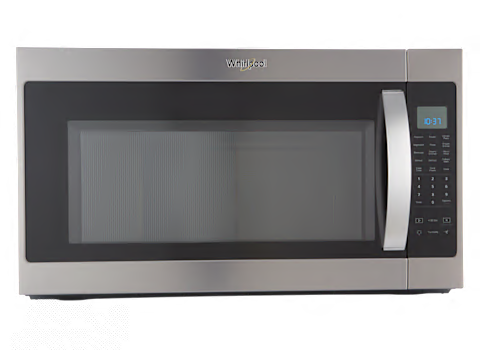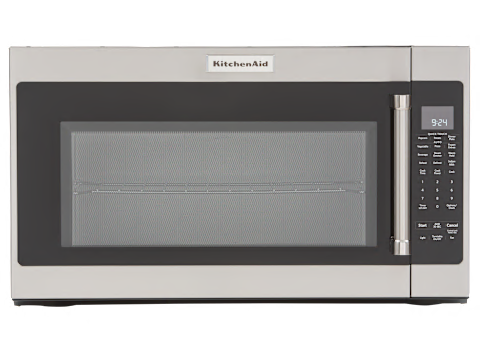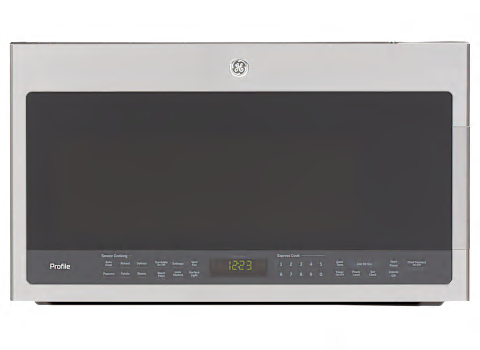CR's interactive tool leverages product costs, depreciation rates, and survey data to help you make the right choice. Plus, we have expert advice on what to do once you’ve decided.

By Mary H.J. Farrell
Data visualizations by Andy Bergmann
When it comes to outfitting a kitchen, most folks choose a beefy range or snazzy refrigerator as the focal point. A microwave is likely an afterthought. But choosing an over-the-range microwave that will give you years of solid service is definitely worth the attention.
As kitchen appliances go, the price of an OTR range microwave can range from downright cheap to the equivalent of a feature-packed refrigerator. The dozens of over-the-range microwaves in Consumer Reports’ tests range from $200 to $2,000, and you may also need to pay to have it installed. Buying a reliable brand is one way to make sure you aren’t tearing your built-in OTR out every few years. But even reliable brands can disappoint, and if that happens, you’ll need to decide whether to replace your microwave or try to get it repaired.
The decision often comes down to how much you paid for your microwave in the first place and whether its age warrants a replacement. That’s what our members told us when we surveyed 61,000 of them who purchased a new OTR microwave between 2012 and 2022.
To help you make the repair vs. replace decision for your own OTR microwave, we’ve created this interactive tool, below. Use the sliders to note the age of your microwave, what you paid for it, and any estimate you have for a repair. The color bar will indicate whether you should definitely repair your microwave, consider a repair, or just replace it.
Following a trend we’ve seen with other major appliances, the calculation about whether to repair or replace an over-the-range microwave often depends on what you paid for it in the first place. Generally speaking, the more someone pays for a major appliance, the more they should weigh a repair vs. a replacement. In the case of OTR microwaves, our survey analysis, which is based on the depreciation of the existing microwave and the cost of a replacement, determined that a broken OTR microwave that costs $300 or less should be repaired if it’s 1 to 3 years old and considered for repair if it’s 4 to 6 years old.
What if you paid a little more, maybe from $300 to $499? Our survey results suggest that you should consider repairing the broken microwave if it’s still under warranty or if it’s 5 years old or less, but you’ll definitely want to replace it if it’s more than 5 years old. Once you spend $500 or more on an OTR microwave, there are more decision points.
Our survey team recommends that you repair any higher-end OTR microwave that’s 4 years old or less and consider repairing one that’s 5 to 7 years old. Replacement is recommended for any OTR microwave that’s 8 years or older. You can see those generalizations in the chart below.
One more point about replacing an OTR microwave. Unless you’re an accomplished carpenter or electrician, you’ll need to factor in the cost of hiring a professional to install the new one. A simple replacement could cost $100 to $200 to install, but if the new model requires electrical, venting, or cabinet modifications, it could cost hundreds more. In that case, replacing an OTR microwave could end up costing you much more than fixing the one you have, just one more thing to keep in mind in your repair vs. replace calculations.
Should You Fix Your Microwave Yourself or Call a Pro?
The thing about microwaves is that while they may look like simple boxes, they have some complicated electronics and aren’t a candidate for most DIY fixes. That’s because a microwave can hold an electrical charge of thousands of volts in its capacitors for hours or even days after it has been unplugged. The Consumer Product Safety Commission reports that people have been electrocuted trying to repair their microwaves. So don’t try it.
While some microwave problems render them inoperable, not every problem requires an immediate repair. A chief complaint our members reported about their microwaves was that they were too noisy. That’s not something you can fix, and microwaves run in such short bursts that it’s likely you can tolerate the brief interruption. If the turntable stops turning, you can live with that for a while and rotate the food yourself so it heats evenly. But if the door won’t shut or the control panel breaks (two of the top three most common problems reported), you’ll need a repair.
Finding the right person to repair your microwave isn’t easy, perhaps because there are so many options. You can call the retailer where you bought it, call the manufacturer, or find an independent repair service in your area. Before reaching out, check to see if your microwave is under warranty (most manufacturers offer a one-year warranty). If it’s covered, the repair may cost less or even be free. In our survey, nearly half of the OTR microwaves that were professionally repaired were covered by a warranty.
In our member survey, we found that owners of OTR microwaves were roughly divided between having the repairs done by manufacturers, independent repair shops, and DIYers, with a smaller number reaching out to retailers for help. Our 2021 survey shows that when a repair was attempted, 86 percent were successful.
The best way to avoid a costly repair is to maintain your microwave, to begin with. Keep it clean, including the filters underneath, which can get gunky with cooking grease. Don’t run it when empty, don’t put anything other than food and microwave-safe dishware inside, and don’t slam the door. (The door latches have to align for the microwave to work correctly.)
Making Greener Choices
• We compiled strategies to save more—and waste less—all around the house.
• Repair vs. Replace: Dishwashers, Dryers, Microwaves, Refrigerators, Washers.
• See our Appliance Brand Reliability Rankings.
For more, see CR’s Guide to Sustainable Living.
If You Toss, Consider the Environment
If your reaction is to just kick your OTR to the curb the next time it acts up or stops performing as it should, think again.
According to NYC Zero Waste, microwaves are considered appliances and not electronic waste. The agency recommends putting discarded microwaves out with your recycling, but the rules may vary from municipality to municipality, so check with your local Department of Public Works.
“Findings from our survey suggest members do dispose of their OTRs in a sustainable way,” says Tian Wang, CR’s survey research associate. According to our 2021 survey, 36 percent of CR members had their discarded OTR microwave hauled away, 25 percent recycled it, and 19 percent got rid of it in a sustainable way by donating it, giving it away, trading it in, or selling it. Another 15 percent just trashed the unit, and 5 percent kept it but stopped using it.
Need a New Microwave?
If despite your best efforts your microwave has reached the end of the road, here are some good alternatives from our full microwave ratings and recommendations.
Whirlpool WMH53521HZ

CR’s take: A top performer from Whirlpool, the WMH53521HZ earns an excellent rating in our heating evenness test, meaning a dish of cold mashed potatoes had few or no cold spots after microwaving. It has a cooking sensor that helps estimate how much time and power you’ll need for each dish, and it fits a 9x15-inch dish, so you can cook a casserole. This microwave is very easy to use, and our testers say it has no discernible flaws. Whirlpool microwaves also get an excellent rating for predicted reliability.
KitchenAid KMHS120ESS

CR’s take: If you tend to take something out of the freezer to make for dinner when you get home from work, the KitchenAid KMHS120ESS is a good bet. It earns an excellent score in our defrosting test, in which we defrost a pound of ground chuck. It also aces the heating evenness test and is very quiet. It has a cooking sensor and comes with a rack, in case you want to cook two dishes at once. KitchenAid OTRs earned a very good score for predicted reliability from our members and a good score for owner satisfaction.
GE Profile PVM9005SJSS

CR’s take: This GE PVM9005SJSS is a good choice for a busy household. It earns an excellent rating in our heating evenness test, in which we reheat a dish of cold mashed potatoes. Speed of heating is also top-notch, and it operates quietly. Our testers found the GE easy to program, and it vents well, something not all OTRs can accomplish. Our members gave GE OTRs a very good score for predicted reliability and an average score for owner satisfaction.
Consumer Reports is an independent, nonprofit organization that works side by side with consumers to create a fairer, safer, and healthier world. CR does not endorse products or services, and does not accept advertising. Copyright © 2023, Consumer Reports, Inc.
